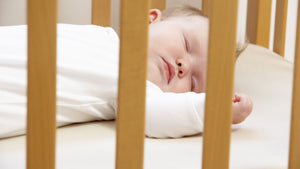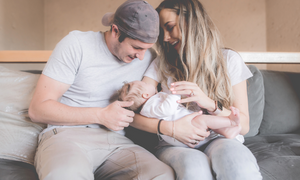Choosing what type of nappy (or diaper) to use on your baby is not necessarily as simple as one might think.
Most standard disposable nappies are manufactured from a whole array of synthetic and toxic ingredients, such as;-
- Chlorine bleaches
- Glues and adhesives
- Lubricants
- Plastic materials that contain Phthalates and Dioxins – known carcinogens
- Isoproylene – a neurotoxin
- Xylene
- Styrene
- Ethyl Benzene
- Chemical dyes
- Artificial deodorisers that can be manufactured from a huge range of synthetically made fragrance ingredients.
What is even more concerning is that the body heat increase, resulting from baby’s skin being enclosed in plastic, increases the dangerous VOC’s (Volatile Organic Compounds), coming off the plastic material in the disposable nappy.
The Health Affects on Babies from Plastic Nappies
There are a whole host of health concerns that are linked to babies wearing plastic disposable nappies.
- A study trying to determine why male fertility has decreased so significantly in recent years, was linked to over-heated testicles caused by male infants wearing plastic disposable nappies.
- In the USA a leading disposable nappy manufacturer was the subject of two lawsuits after their “Dry Max Technology” caused serious diaper rashes, likened by some parents to chemical burns.
- Nappy rash, skin allergies, asthma and respiratory illnesses, have all been linked to the dyes in disposable plastic nappies.
The Nappy Mountain in our Landfill – Pollution Extreme
Plastic disposable nappies ultimately end up as landfill, seriously polluting the environment. Here they lie, leaching toxic, hazardous, VOC’s into the environment and the air we breathe.
Environment Victoria states that each year, just one baby who wears disposable nappies contributes 700kg of dirty nappies into landfill!
Safer Nappy Options for Both Baby and the Environment
Thankfully there is more than one alternative to the synthetic disposable nappy!
You Can Still Use a Disposable Nappy - Just Choose a Biodegradable One
Biodegradable disposable nappies are produced using sustainable materials that break down naturally without harming the environment. They are also free from known toxic materials.
These disposable nappies are free from bleaches, petrochemical-based moisturisers, artificial fragrances and PVC plastic (one of the most notoriously unhealthy plastics on the planet).
Yes they are generally, but not always, a bit more expensive, but the couple of extra dollars when it comes to your baby’s health, is arguably well worth it.
The brands I used on my own children were Bambo Nature and Moltex. Now a few years on there are a couple of other eco-disposable brands around. You just need to make sure you scan the ingredients listing for hidden toxins. Look out for the word “fragrance” because if the actual ingredients of the fragrance are not disclosed, there is a possibility that it is a synthetic based fragrance, which is not a healthy choice for your baby.
My own children never got nappy rash, even if they sat in a wet nappy a lot longer than they probably should have. The couple of times I did see a hint of nappy rash developing, was when I was out and about and nappy-less and I had to borrow a conventional brand of disposable nappy from a friend. This was proof enough for me! I was more than willing to stick with my eco, disposable nappy brands.
Going the Cloth or Reusable Nappy Route
Thankfully the modern version of the cloth nappy means no more dangerous nappy pins or complicated folding!
Yes you have to wash them, but you soon get into a routine.
Yes the initial outlay to buy enough cloth nappies to have on hand is costly, but this is a once off expense and in the end you save big time!
But… not all cloth nappies are created equal. Just like with disposable nappies some are made from safer materials than others.
By far the safest choice is certified organic cotton or bamboo fiber.
Never use PVC protector pilcher style pants over the top of a cloth nappy.
What you choose to wash a cloth nappy in is also extremely important.
Steer clear of chlorine bleaches, highly fragranced and synthetic based laundry detergents and fabric softeners. The residues that remain in the nappy can be absorbed through baby’s skin – the biggest human organ, plus they fed out into the waterways, polluting our fragile, eco-system.
Instead choose natural, safer and environmentally friendly soaps to wash your baby’s cloth nappies in.
A really great, safe and extremely economic washing option is to use 100% Natural SoapNuts.
About the Author:
Nicole Groch is a loving mother, cruelty-free hair and makeup artist and founder of LivingSafe. After welcoming her first child 2007, she realised there was a serious lack of information about the safety of the materials and ingredients in baby products, toys, baby skincare and even baby foods. Since then, Nicole has spent years researching and writing about safe, healthy and eco-friendly alternatives for mums and bubs.
Our Products
-

01. Guide to a Healthy Pregnancy
$55 -

02. Positive Birthing Course
$55 -

03. Baby Feeding Guide
$55 -

04. Baby Sleep Guide - First 12 Months
$55 -

05. Positive Parenting Course 1 - 3 Years
$55
-
 Is it normal for babies to be noisy?
Is it normal for babies to be noisy?
 Recently we asked Natalie van Winckel, Senior Early Parenting Sleep Consultant and Education Lead from Nourish Baby and Safe Sleep Space, to share her insights into what separates noisy babies from others who are less vocal.
Recently we asked Natalie van Winckel, Senior Early Parenting Sleep Consultant and Education Lead from Nourish Baby and Safe Sleep Space, to share her insights into what separates noisy babies from others who are less vocal. -
 Contraception after birth
Contraception after birth
Most women are fertile two weeks before their period starts. However, breastfeeding can delay the return of periods, making it hard for women to know with any confidence when their ‘fertile window’ may be. This is why some women conceive again before their periods have come back.





 Is it normal for babies to be noisy?
Is it normal for babies to be noisy?
 Contraception after birth
Contraception after birth








